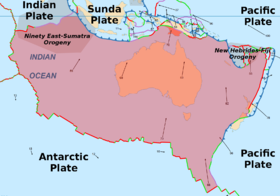Australian Plate
| Australian Plate | |
|---|---|
 |
|
| Type | Major |
| Approx. Area | 47,000,000 km2 |
| Movement1 | northeast |
| Speed1 | 62–70 mm/year |
| Features | Australia, New Guinea, New Zealand, Indian Ocean |
| 1Relative to the African Plate | |
The Australian Plate is a major tectonic plate in the eastern and, largely, in the southern hemispheres. Originally a part of the ancient continent of Gondwana, Australia remained connected to India and Antarctica until approximately 100 million years ago when India broke away and began moving north. Australia and Antarctica began rifting 85 million years ago and completely separated roughly 45 million years ago The Australian plate later fused with the adjacent Indian Plate beneath the Indian Ocean to form a single Indo-Australian Plate. However, recent studies suggest that the two plates have once again split apart and have been separate plates for at least 3 million years and likely longer. The Australian plate includes the continent of Australia, including Tasmania, as well portions of New Guinea, New Zealand, and the Indian Ocean basin.
The northeasterly side is a complex but generally convergent boundary with the Pacific Plate. The Pacific Plate is subducting under the Australian Plate, which forms the Tonga and Kermadec Trenches, and the parallel Tonga and Kermadec island arcs. It has also uplifted the eastern parts of New Zealand's North Island.
...
Wikipedia
